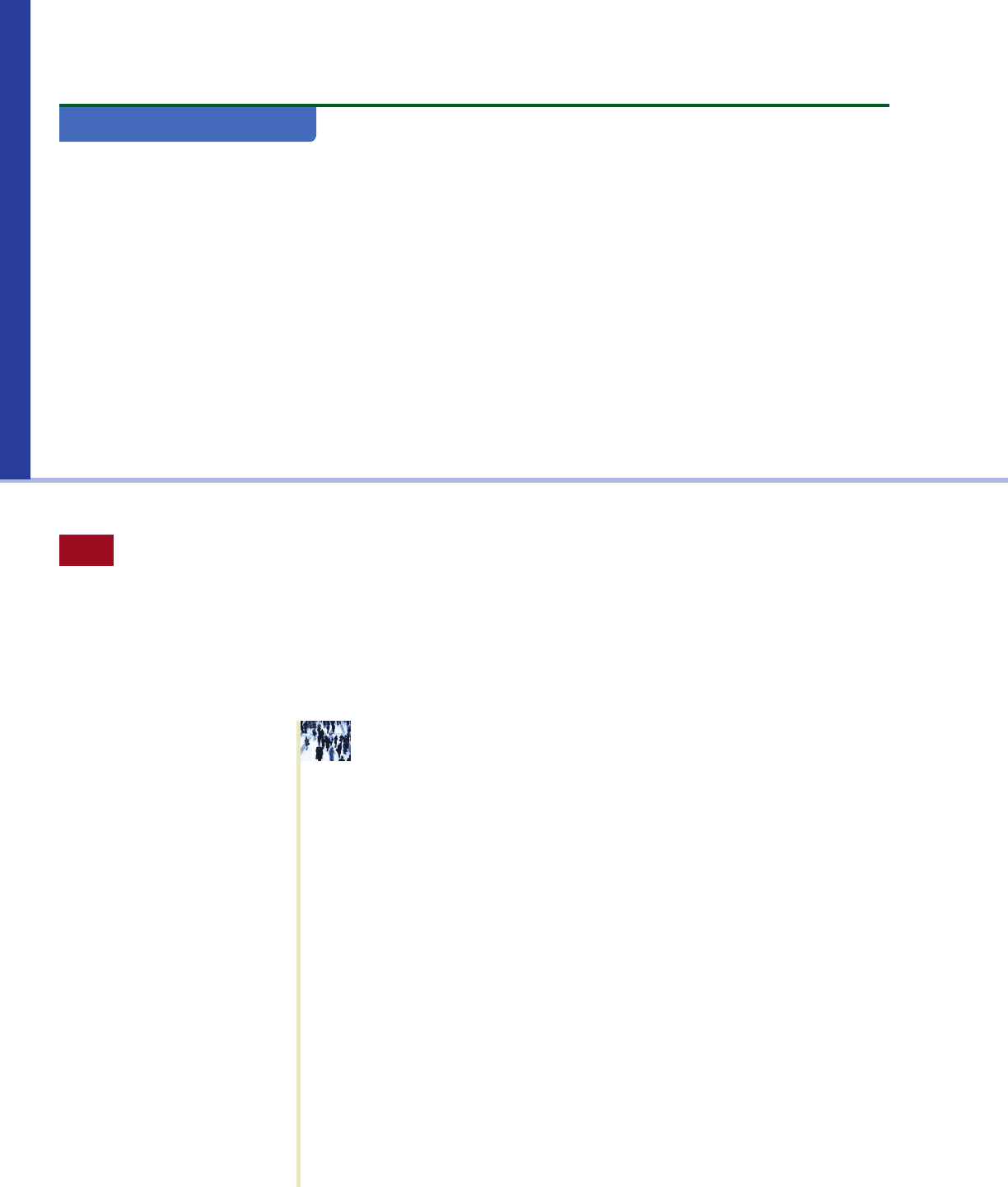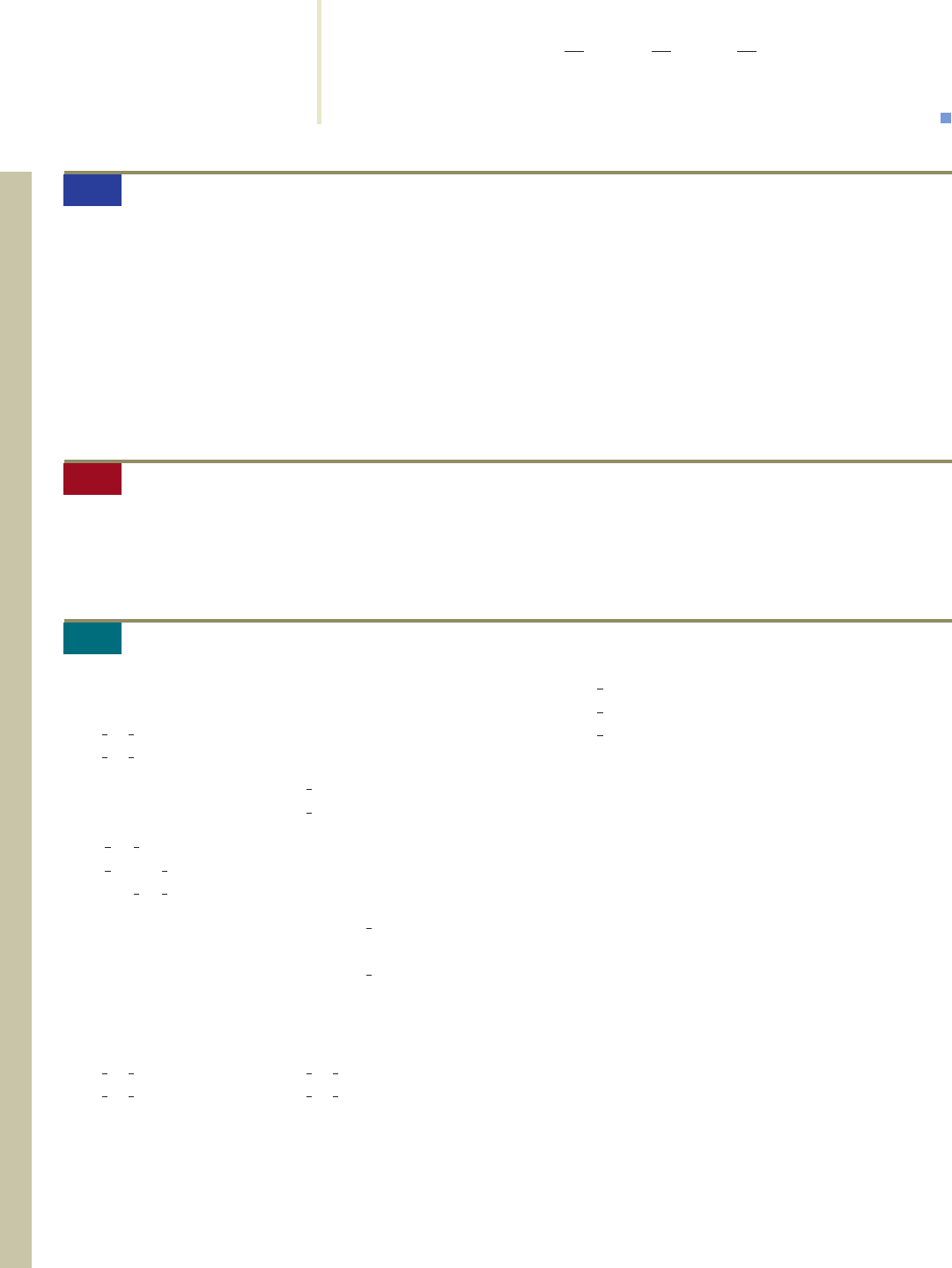Tan S.T. Finite Mathematics for the Managerial, Life, and Social Sciences
Подождите немного. Документ загружается.


22. C
OMMUTER
T
RENDS
Within a large metropolitan area, 20%
of the commuters currently use the public transportation
system, whereas the remaining 80% commute via automo-
bile. The city has recently revitalized and expanded its
public transportation system. It is expected that 6 mo from
now 30% of those who are now commuting to work via
automobile will switch to public transportation, and 70%
will continue to commute via automobile. At the same
time, it is expected that 20% of those now using public
transportation will commute via automobile and 80% will
continue to use public transportation.
a. Construct the transition matrix for the Markov chain
that describes the change in the mode of transportation
used by these commuters.
b. Find the initial distribution vector for this Markov
chain.
c. What percentage of the commuters are expected to use
public transportation 6 mo from now?
23. U
RBAN
–S
UBURBAN
P
OPULATION
F
LOW
Refer to Example 4.
If the initial probability distribution is
X
0
City
Suburb
what will be the population distribution of the city after 1
yr? After 2 yr?
24. Refer to Example 6. If the initial distribution vector for the
location of the taxis is
Zone I
X
0
Zone II
Zone III
what will be the distribution after all of them have made
one pickup and discharge?
25. M
ARKET
S
HARE
At a certain university, three bookstores—
the University Bookstore, the Campus Bookstore, and the
Book Mart—currently serve the university community.
From a survey conducted at the beginning of the fall quar-
ter, it was found that the University Bookstore and the
Campus Bookstore each had 40% of the market, whereas
the Book Mart had 20% of the market. Each quarter the
University Bookstore retains 80% of its customers but
loses 10% to the Campus Bookstore and 10% to the Book
Mart. The Campus Bookstore retains 75% of its customers
but loses 10% to the University Bookstore and 15% to the
Book Mart. The Book Mart retains 90% of its customers
but loses 5% to the University Bookstore and 5% to the
Campus Bookstore. If these trends continue, what percent-
age of the market will each store have at the beginning of
the second quarter? The third quarter?
26. M
ARKET
S
HARE OF
A
UTO
M
ANUFACTURERS
In a study of the
domestic market share of the three major automobile man-
ufacturers A, B, and C in a certain country, it was found
that their current market shares were 60%, 30%, and 10%,
respectively. Furthermore, it was found that of the cus-
tomers who bought a car manufactured by A, 75% would
again buy a car manufactured by A, 15% would buy a car
£
.6
.2
.2
§
c
.80
.20
d
manufactured by B, and 10% would buy a car manufac-
tured by C. Of the customers who bought a car manufac-
tured by B, 90% would again buy a car manufactured by B,
whereas 5% each would buy cars manufactured by A and
C. Finally, of the customers who bought a car manufac-
tured by C, 85% would again buy a car manufactured by C,
5% would buy a car manufactured by A, and 10% would
buy a car manufactured by B. Assuming that these senti-
ments reflect the buying habits of customers in the future,
determine the market share that will be held by each man-
ufacturer after the next two model years.
27. C
OLLEGE
M
AJORS
Records compiled by the Admissions
Office at a state university indicating the percentage of stu-
dents who change their major each year are shown in the
following transition matrix. Of the freshmen now at the
university, 30% have chosen their major field in Business,
30% in the Humanities, 20% in Education, and 20% in the
Natural Sciences and other fields. Assuming that this trend
continues, find the percentage of these students that will be
majoring in each of the given areas in their senior year.
Hint: Find T
3
X
0
.
Nat. Sc.
and
Bus. Hum. Educ. others
Business
Humanities
Education
Nat. Sci. and others
28. H
OMEOWNERS
’ C
HOICE OF
E
NERGY
A study conducted by
the Urban Energy Commission in a large metropolitan area
indicates the probabilities that homeowners within the area
will use certain heating fuels or solar energy during the
next 10 yr as the major source of heat for their homes. The
transition matrix representing the transition probabilities
from one state to another is
Elec. Gas Oil Solar
Electricity
Natural gas
Fuel oil
Solar energy
Among homeowners within the area, 20% currently use
electricity, 35% use natural gas, 40% use oil, and 5% use
solar energy as the major source of heat for their homes.
What is the expected distribution of the homeowners who
will be using each type of heating fuel or solar energy
within the next decade?
In Exercises 29 and 30, determine whether the statement
is true or false. If it is true, explain why it is true. If it is
false, give an example to show why it is false.
29. A Markov chain is a process in which the outcomes at any
stage of the experiment depend on the outcomes of the pre-
ceding stages.
30. The sum of the entries in each column of a transition
matrix must not exceed 1.
≥
.70000
.15 .90 .20 .05
.05 .02 .75 0
.10 .08 .05 .95
¥
≥
.80 .10 .20 .10
.10 .70 .10 .05
.05 .10 .60 .05
.05 .10 .10 .80
¥
492 9 MARKOV CHAINS AND THE THEORY OF GAMES
87533_09_ch9_p483-536 1/30/08 10:12 AM Page 492

1. The required transition matrix is
T
2. a. The initial distribution vector is
X
0
b. The vector representing the market share of each super-
market after 1 yr is
X
1
TX
0
£
.80 .05 .10
.05 .90 .15
.15 .05 .75
§ £
.4
.3
.3
§ £
.365
.335
.300
§
£
.4
.3
.3
§
£
.80 .05 .10
.05 .90 .15
.15 .05 .75
§
That is, after 1 yr supermarket A will command a 36.5%
market share, supermarket B will have a 33.5% share, and
supermarket C will have a 30% market share.
The vector representing the market share of the super-
markets after 2 yr is
X
2
TX
1
That is, 2 yr later the market shares of supermarkets A,
B, and C will be 33.88%, 36.48%, and 29.65%, respec-
tively.
£
.80 .05 .10
.05 .90 .15
.15 .05 .75
§ £
.365
.335
.300
§⬇ £
.33875
.36475
.29650
§
9.1 MARKOV CHAINS 493
9.1 Solutions to Self-Check Exercises
USING
TECHNOLOGY
Finding Distribution Vectors
Since the computation of the probability distribution of a system after a certain num-
ber of observations involves matrix multiplication, a graphing utility may be used to
facilitate the work.
EXAMPLE 1
Consider the problem posed in Example 6, page 488, where
T and X
0
Verify that
X
2
as obtained in that example.
Solution
First, we enter the matrix X
0
as the matrix A and the matrix T as the
matrix B. Then, performing the indicated multiplication, we find that
B^2*A
That is,
X
2
T
2
X
0
as was to be shown.
£
.4965
.3000
.2035
§
£
.4965
.3000
.2035
§
£
.4965
.3000
.2035
§
£
.80
.15
.05
§£
.6 .4 .3
.3 .3 .3
.1 .3 .4
§
(continued)
87533_09_ch9_p483-536 1/30/08 10:12 AM Page 493

494 9 MARKOV CHAINS AND THE THEORY OF GAMES
In Exercises 1–2, find X
5
(the probability distribution of
the system after five observations) for the distribution
vector X
0
and the transition matrix T.
1. X
0
冤冥
, T
冤冥
.2 .2 .3 .2 .1
.1 .2 .1 .2 .1
.3 .4 .1 .3 .3
.2 .1 .2 .2 .2
.2 .1 .3 .1 .3
.2
.3
.2
.1
.2
3. Refer to Exercise 26 on page 492. Using the same data,
determine the market share that will be held by each man-
ufacturer five model years after the study began.
4. Refer to Exercise 25 on page 492. Using the same data,
determine the expected market share that each store will
have at the beginning of the fourth quarter.
Steady-State Distribution Vectors
In the last section, we derived a formula for computing the likelihood that a physical
system will be in any one of the possible states associated with each stage of a Markov
process describing the system. In this section we use this formula to help us investi-
gate the long-term trends of certain Markov processes.
APPLIED EXAMPLE 1
Educational Status of Women A survey con-
ducted by the National Commission on the Educational Status of Women
reveals that 70% of the daughters of women who have completed 2 or more years
of college have also completed 2 or more years of college, whereas 20% of the
daughters of women who have had less than 2 years of college have completed
2 or more years of college. If this trend continues, determine, in the long run, the
percentage of women in the population who will have completed at least 2 years
of college given that currently only 20% of the women have completed at least
2 years of college.
Solution
This problem may be viewed as a Markov process with two possible
states: “completed 2 or more years of college” (state 1) and “completed less than
2 years of college” (state 2). The transition matrix associated with this Markov
chain is given by
T
The initial distribution vector is given by
X
0
To study the long-term trend pertaining to this particular aspect of the educa-
tional status of women, let’s compute X
1
, X
2
, . . . , the distribution vectors associ-
c
.2
.8
d
c
.7 .2
.3 .8
d
TECHNOLOGY EXERCISES
9.2 Regular Markov Chains
2. X
0
冤冥
, T
冤冥
.3 .2 .1 .3 .1
.2 .1 .2 .1 .2
.1 .2 .3 .2 .2
.1 .3 .2 .3 .2
.3 .2 .2 .1 .3
.1
.2
.2
.3
.2
87533_09_ch9_p483-536 1/30/08 10:12 AM Page 494

9.2 REGULAR MARKOV CHAINS 495
ated with the Markov process under consideration. These vectors give the per-
centage of women with 2 or more years of college and that of women with less
than 2 years of college after one generation, after two generations, and so on.
With the aid of Formula (1), Section 9.1, we find (to four decimal places)
After one generation X
1
TX
0
After two generations X
2
TX
1
After three generations X
3
TX
2
Proceeding further, we obtain the following sequence of vectors:
X
4
X
5
⬇
X
6
⬇
X
7
⬇
X
8
⬇
X
9
⬇
After ten generations X
10
⬇
From the results of these computations, we see that as m increases, the proba-
bility distribution vector X
m
approaches the probability distribution vector
or
Such a vector is called the limiting, or steady-state, distribution vector for the
system. We interpret these results in the following way: Initially, 20% of the
women in the population have completed 2 or more years of college, whereas
80% have completed less than 2 years of college. After one generation, the for-
mer has increased to 30% of the population, and the latter has dropped to 70% of
the population. The trend continues, and eventually, 40% of all women in future
generations will have completed 2 or more years of college, whereas 60% will
have completed less than 2 years of college.
To explain the foregoing result, let’s analyze Formula (1), Section 9.1, more
closely. Now, the initial distribution vector X
0
is a constant; that is, it remains fixed
throughout our computation of X
1
, X
2
, . . . . It appears reasonable, therefore, to con-
jecture that this phenomenon is a result of the behavior of the powers, T
m
, of the tran-
sition matrix T. Pursuing this line of investigation, we compute
T
2
T
3
c
.7 .2
.3 .8
d c
.55 .3
.45 .7
d c
.475 .35
.525 .65
d
c
.7 .2
.3 .8
d c
.7 .2
.3 .8
d c
.55 .3
.45 .7
d
c
2
5
3
5
dc
.4
.6
d
c
.3998
.6002
d
c
.3996
.6004
d
c
.3992
.6008
d
c
.3984
.6016
d
c
.3969
.6031
d
c
.3938
.6062
d
c
.3875
.6125
d
c
.7 .2
.3 .8
dc
.35
.65
d c
.375
.625
d
c
.7 .2
.3 .8
dc
.3
.7
d c
.35
.65
d
c
.7 .2
.3 .8
dc
.2
.8
d c
.3
.7
d
87533_09_ch9_p483-536 1/30/08 10:12 AM Page 495

Proceeding further, we obtain the following sequence of matrices:
T
4
T
5
⬇
T
6
⬇ T
7
⬇
T
8
⬇ T
9
⬇
T
10
⬇ T
11
⬇
These results show that the powers T
m
of the transition matrix T tend toward a
fixed matrix as m gets larger and larger. In this case, the “limiting matrix” is the matrix
L or
Such a matrix is called the steady-state matrix for the system. Thus, as suspected, the
long-term behavior of a Markov process such as the one in this example depends on
the behavior of the limiting matrix of the powers of the transition matrix—the steady-
state matrix for the system. In view of this, the long-term (steady-state) distribution
vector for this problem may be found by computing the product
LX
0
which agrees with the result obtained earlier.
Next, since the transition matrix T in this situation seems to have a stabilizing
effect over the long term, we are led to wonder whether the steady state would be
reached regardless of the initial state of the system. To answer this question, suppose
the initial distribution vector is
X
0
Then, as before, the steady-state distribution vector is given by
LX
0
Thus, the steady state is reached regardless of the initial state of the system!
Regular Markov Chains
The transition matrix T of Example 1 has several important properties, which we
emphasized in the foregoing discussion. First, the sequence T, T
2
, T
3
, . . . approaches
a steady-state matrix in which the columns of the limiting matrix are all equal and all
entries are positive. A matrix T having this property is called a regular Markov chain.
Regular Markov Chain
A stochastic matrix T is a regular Markov chain if the sequence
T, T
2
, T
3
, . . .
approaches a steady-state matrix in which the columns of the limiting matrix are
all equal and all the entries are positive.
c
.40 .40
.60 .60
d c
p
1 p
d c
.40
.60
d
c
p
1 p
d
c
.40 .40
.60 .60
d c
.2
.8
d c
.40
.60
d
c
2
5
2
5
3
5
3
5
dc
.40 .40
.60 .60
d
c
.4003 .3998
.5997 .6002
dc
.4006 .3996
.5994 .6004
d
c
.4012 .3992
.5988 .6008
dc
.4023 .3984
.5977 .6016
d
c
.4047 .3969
.5953 .6031
dc
.4094 .3938
.5906 .6062
d
c
.4188 .3875
.5813 .6125
dc
.4375 .375
.5625 .625
d
496 9 MARKOV CHAINS AND THE THEORY OF GAMES
87533_09_ch9_p483-536 1/30/08 10:12 AM Page 496

It can be shown that a stochastic matrix T is regular if and only if some power of
T has entries that are all positive. Second, as in the case of Example 1, a Markov chain
with a regular transition matrix has a steady-state distribution vector whose column is
identical to a column in the steady-state matrix; thus, this steady-state distribution vec-
tor is always reached regardless of the initial distribution vector.
We will return to computations involving regular Markov chains, but for
the moment let’s see how one may determine whether a given matrix is indeed
regular.
EXAMPLE 2
Determine which of the following matrices are regular.
a. b. c.
Solution
a. Since all the entries of the matrix are positive, the given matrix is regular. Note
that this is the transition matrix of Example 1.
b. In this case, one of the entries of the given matrix is equal to zero. Let’s
compute
앖
All entries are positive.
Since the second power of the matrix has entries that are all positive, we con-
clude that the given matrix is in fact regular.
c. Denote the given matrix by A. Then,
A
A
2
A
3
Observe that A
3
A. It therefore follows that A
4
A
2
, A
5
A, and so on. In
other words, any power of A must coincide with either A or A
2
. Since not all
entries of A and A
2
are positive, the same is true of any power of A. We conclude
accordingly that the given matrix is not regular.
We now return to the study of regular Markov chains. In Example 1, we found the
steady-state distribution vector associated with a regular Markov chain by studying
the limiting behavior of a sequence of distribution vectors. Alternatively, as pointed
out in the subsequent discussion, the steady-state distribution vector may also be
obtained by first determining the steady-state matrix associated with the regular
Markov chain.
Fortunately, there is a relatively simple procedure for finding the steady-state dis-
tribution vector associated with a regular Markov process. It does not involve the
c
01
10
d c
10
01
d c
01
10
d
c
01
10
d c
01
10
d c
10
01
d
c
01
10
d
c
.4 1
.6 0
d
2
c
.4 1
.6 0
d c
.4 1
.6 0
d c
.76 .4
.24 .6
d
c
01
10
dc
.4 .1
.6 0
dc
.7 .2
.3 .8
d
9.2 REGULAR MARKOV CHAINS 497
———
씮
———
씮
Explore & Discuss
Find the set of all 2 2 stochas-
tic matrices with elements that
are either 0 or 1.
Not all entries are positive.
87533_09_ch9_p483-536 1/30/08 10:12 AM Page 497

rather tedious computations required to obtain the sequences in Example 1. The pro-
cedure follows.
A justification of the foregoing procedure is given in Exercise 29.
EXAMPLE 3
Find the steady-state distribution vector for the regular Markov
chain whose transition matrix is
T See Example 1.
Solution
Let
X
be the steady-state distribution vector associated with the Markov process, where the
numbers x and y are to be determined. The condition TX X translates into the
matrix equation
or, equivalently, the system of linear equations
0.7x 0.2y x
0.3x 0.8y y
But each of the equations that make up this system of equations is equivalent to the
single equation
0.3x 0.2y 0
0.7
x
x
0.2
y
0
0.3
x
0.8
y
y
0
Next, the condition that the sum of the elements of X is 1 gives
x y 1
Thus, the simultaneous fulfillment of the two conditions implies that x and y are the
solutions of the system
0.3x 0.2y 0
x y 1
Solving the first equation for x, we obtain
x y
2
3
c
.7 .2
.3 .8
d c
x
y
d c
x
y
d
c
x
y
d
c
.7 .2
.3 .8
d
Finding the Steady-State Distribution Vector
Let T be a regular stochastic matrix. Then the steady-state distribution vector X
may be found by solving the vector equation
TX X
together with the condition that the sum of the elements of the vector X be equal
to 1.
498 9 MARKOV CHAINS AND THE THEORY OF GAMES
87533_09_ch9_p483-536 1/30/08 10:12 AM Page 498

which, upon substitution into the second, yields
y y 1
y
Thus, x , and the required steady-state distribution vector is given by
X
which agrees with the result obtained earlier.
APPLIED EXAMPLE 4
Taxicab Movement In Example 6, Section
9.1, we showed that the transition matrix that described the movement of
taxis from zone to zone was given by the regular stochastic matrix
T
Use this information to determine the long-term distribution of the taxis in the
three zones.
Solution
Let
X
be the steady-state distribution vector associated with the Markov process under
consideration, where x, y, and z are to be determined. The condition TX X
translates into the matrix equation
or, equivalently, the system of linear equations
0.6x 0.4y 0.3z x
0.3x 0.3y 0.3z y
0.1x 0.3y 0.4z z
The system simplifies into
4x 4y 3z 0
3x 7y 3z 0
x 3y 6z 0
Since x y z 1 as well, we are required to solve the system
x y z 1
4x 4y 3z 0
3x 7y 3z 0
x 3y 6z 0
£
.6 .4 .3
.3 .3 .3
.1 .3 .4
§ £
x
y
z
§ £
x
y
z
§
£
x
y
z
§
£
.6 .4 .3
.3 .3 .3
.1 .3 .4
§
c
2
5
3
5
d
2
5
3
5
2
3
9.2 REGULAR MARKOV CHAINS 499
87533_09_ch9_p483-536 1/30/08 10:12 AM Page 499

500 9 MARKOV CHAINS AND THE THEORY OF GAMES
Using the Gauss–Jordan elimination procedure of Chapter 2, we find that
x y z
or x ⬇ 0.47, y 0.30, and z ⬇ 0.23. Thus, in the long run, approximately 47% of
the taxis will be in zone I, 30% in zone II, and 23% in zone III.
8
35
3
10
33
70
9.2 Exercises
9.2 Self-Check Exercises
9.2 Concept Questions
1. Find the steady-state distribution vector for the regular
Markov chain whose transition matrix is
T
2. Three supermarkets serve a certain section of a city. Dur-
ing the year, supermarket A is expected to retain 80% of its
customers, lose 5% of its customers to supermarket B, and
lose 15% to supermarket C. Supermarket B is expected to
c
.5 .8
.5 .2
d
retain 90% of its customers and lose 5% to each of super-
market A and supermarket C. Supermarket C is expected to
retain 75% of its customers, lose 10% to supermarket A,
and lose 15% to supermarket B. If these trends continue,
what will be the market share of each supermarket in the
long run?
Solutions to Self-Check Exercises 9.2 can be found on
page 502.
1. Explain (a) a steady-state distribution vector, (b) a steady-
state matrix, and (c) a regular Markov chain.
2. How do you find the steady-state distribution vector given
a regular stochastic matrix T associated with a Markov
process?
In Exercises 1–8, determine which of the matrices are
regular.
1. 2.
3. 4.
5. 6.
7. 8.
In Exercises 9–16, find the steady-state vector for the
transition matrix.
9. 10.
11. 12. c
.9 1
.1 0
dc
.5 .2
.5 .8
d
c
4
5
3
5
1
5
2
5
dc
1
3
1
4
2
3
3
4
d
£
00
1
4
100
01
3
4
§£
.7 .2 .3
.3 .8 .3
00.4
§
£
1.3.1
0.4.8
0.3.1
§£
1
2
3
4
0
1
2
0
1
2
0
1
4
1
2
§
c
1
3
0
2
3
1
dc
1.8
0.2
d
c
0.3
1.7
dc
2
5
3
4
3
5
1
4
d
13. 14.
15. 16.
17. P
SYCHOLOGY
E
XPERIMENTS
A psychologist conducts an
experiment in which a mouse is placed in a
T-maze, where
it has a choice at the
T-junction of turning left and receiv-
ing a reward (cheese) or turning right and receiving a mild
shock. At the end of each trial a record is kept of the
mouse’s response. It is observed that the mouse is as likely
to turn left (state 1) as right (state 2) during the first trial.
In subsequent trials, however, the observation is made that
if the mouse had turned left in the previous trial, then the
probability that it will turn left in the next trial is .8,
whereas the probability that it will turn right is .2. If the
mouse had turned right in the previous trial, then the prob-
ability that it will turn right in the next trial is .1, whereas
the probability that it will turn left is .9. In the long run,
what percentage of the time will the mouse turn left at the
T-junction?
£
.1 .2 .3
.1 .2 .3
.8 .6 .4
§£
.2 0 .3
0.6.4
.8 .4 .3
§
£
.6 .3 0
.4 .4 .6
0.3.4
§£
0
1
8
1
1
5
8
0
0
1
4
0
§
87533_09_ch9_p483-536 1/30/08 10:12 AM Page 500

18. C
OMMUTER
T
RENDS
Within a large metropolitan area, 20%
of the commuters currently use the public transportation
system, whereas the remaining 80% commute via automo-
bile. The city has recently revitalized and expanded its pub-
lic transportation system. It is expected that 6 mo from now
30% of those who are now commuting to work via auto-
mobile will switch to public transportation, and 70% will
continue to commute via automobile. At the same time, it is
expected that 20% of those now using public transportation
will commute via automobile, and 80% will continue to use
public transportation. In the long run, what percentage of
the commuters will be using public transportation?
19. O
NE
-
AND
T
WO
-I
NCOME
F
AMILIES
From data compiled over
a 10-yr period by Manpower, Inc., in a statewide study of
married couples in which at least one spouse was working,
the following transition matrix was constructed. It gives
the transitional probabilities for one and two wage earners
among married couples.
Current State
1 Wage 2 Wage
Earner Earners
Next State
1 Wage Earner .72 .12
2 Wage Earners .28 .88
At the present time, 48% of the married couples (in which
at least one spouse is working) have one wage earner, and
52% have two wage earners. Assuming that this trend con-
tinues, what will be the distribution of one- and two-wage
earner families among married couples in this area 10 yr
from now? Over the long run?
20. P
ROFESSIONAL
W
OMEN
From data compiled over a 5-yr
period by Women’s Daily in a study of the number of
women in the professions, the following transition matrix
was constructed. It gives the transitional probabilities for
the number of men and women in the professions.
Current State
Men Women
Men .95 .04
Next State
Women .05 .96
As of the beginning of 1986, 52.9% of professional jobs
were held by men. If this trend continues, what percentage
of professional jobs will be held by women in the long run?
21. B
UYING
T
RENDS OF
H
OME
B
UYERS
From data collected over
the past decade by the Association of Realtors of a certain
city, the following transition matrix was obtained. The
matrix describes the buying pattern of home buyers who
buy single-family homes (S) or condominiums (C ).
Current State
SC
S .85 .35
Next State
C .15 .65
9.2 REGULAR MARKOV CHAINS 501
Currently, 80% of the homeowners live in single-family
homes, whereas 20% live in condominiums. If this trend
continues, what percentage of homeowners in this city will
own single-family homes and condominiums 2 decades
from now? In the long run?
22. H
OMEOWNERS
’ C
HOICE OF
E
NERGY
A study conducted by
the Urban Energy Commission in a large metropolitan area
indicates the probabilities that homeowners within the area
will use certain heating fuels or solar energy during the
next 10 yr as the major source of heat for their homes. The
following transition matrix represents the transition proba-
bilities from one state to another:
Elec. Gas Oil Solar
Electricity
Natural gas
Fuel oil
Solar energy
Among the homeowners within the area, 20% currently use
electricity, 35% use natural gas, 40% use oil, and 5% use
solar energy as their major source of heat for their homes.
In the long run, what percentage of homeowners within the
area will be using solar energy as their major source of
heating fuel?
23. N
ETWORK
N
EWS
V
IEWERSHIP
A television poll was con-
ducted among regular viewers of the national news in a
certain region where the three national networks share the
same time slot for the evening news. Results of the poll
indicate that 30% of the viewers watch the ABC evening
news, 40% watch the CBS evening news, and 30% watch
the NBC evening news. Furthermore, it was found that of
those viewers who watched the ABC evening news during
1 wk, 80% would again watch the ABC evening news dur-
ing the next week, 10% would watch the CBS news, and
10% would watch the NBC news. Of those viewers who
watched the CBS evening news during 1 wk, 85% would
again watch the CBS evening news during the next week,
10% would watch the ABC news, and 5% would watch the
NBC news. Of those viewers who watched the NBC
evening news during 1 wk, 85% would again watch the
NBC news during the next week, 10% would watch ABC,
and 5% would watch CBS.
a. What share of the audience consisting of regular view-
ers of the national news will each network command
after 2 wk?
b. In the long run, what share of the audience will each
network command?
24. N
ETWORK
N
EWS
V
IEWERSHIP
Refer to Exercise 23. If the
initial distribution vector is
ABC
X
0
CBS
NBC
what share of the audience will each network command in
the long run?
£
.40
.40
.20
§
≥
.70 0 .10 0
.15 .90 .10 .05
.05 .02 .75 .05
.10 .08 .05 .90
¥
87533_09_ch9_p483-536 1/30/08 10:12 AM Page 501
